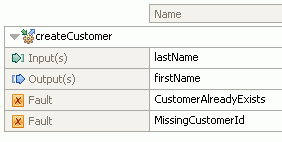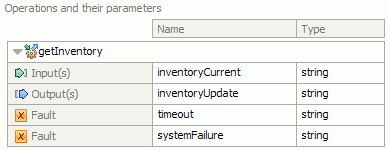IBM BPM, V8.0.1, All platforms > Authoring services in Integration Designer > Services and service-related functions > Work with data handlers, faults and registries > Handling faults in bindings
Faults overview
Errors issued at run time in a Service Oriented Architecture (SOA) application can either be from a Service Component Architecture (SCA) application to another non-SCA application or from a non-SCA application to the SCA one.
The following sections provide an overview of how faults can be handled by your application, beginning with the types of faults.
- Business faults
- Runtime exceptions
- Fault handling on imports and exports
- Data format considerations
- Wizard for configuring faults
- Fault selectors
- Fault data handlers
Business faults
Business faults are business errors or exceptions that occur during processing. Consider the following interface which has a createCustomer operation on it. This operation has two business faults defined on it: CustomerAlreadyExists and MissingCustomerId.

In this example, if the client sends a request to create a customer to this SCA application and that customer already exists, the component throws a CustomerAlreadyExists fault to the export. The export now needs to propagate this business fault back to the calling client.
This is achieved by the fault data handler that is setup on the export binding. When a business exception is received by the export binding, the binding calls the fault data handler with the data object from the service business exception.
- The binding calls the appropriate data handler with the data object.
- The fault data handler transforms the fault data object to a response message and returns it to the export binding.
- The export returns the response message to the client.
If the service business exception contains the name of the fault, then the data handler setup on the fault will be called. If the service business exception does not contain the name of the fault, then the fault name will be derived by matching the fault types.
Runtime exceptions
Runtime exceptions are classified as all the exceptions that occur in the SCA application due to processing of the request and do not correspond to a business fault. Runtime exceptions are not defined on the interface as business faults are. In certain scenarios, you may want to propagate these runtime exceptions to the client application so that the client application can take the appropriate action.
For example, if a client sends a request to create a customer to the SCA application and an authorization error occurs during processing of this request, the component throws a runtime exception. This runtime exception has to be propagated back to the calling client so it can take the appropriate action regarding the authorization. This is achieved by the runtime exception data handler configured on the export binding. The processing of a runtime exception is similar to the processing of a business fault.
If a runtime exception data handler was set up, the following processing occurs:
- The export binding calls the appropriate data handler with the service runtime exception.
- The data handler transforms the fault data object to a response message and returns it to the export binding.
- The export returns the response message to the client.
Fault handling on imports and exports
To handle both business faults and runtime exceptions, you can set up fault handling on imports and exports. Handling faults on either imports or exports is optional. You would likely create fault handlers for the most common errors that could occur at run time in your application.
You can create fault handlers on imports and exports for the following bindings: JMS, MQ JMS, generic JMS, MQ and HTTP. You can also add them to your imports and exports created with EIS bindings for services using adapters, except for those services that use CICS and IMS adapters.
In the following diagram of an import, a fault occurs on the external service that the import is calling. The numbers refer to the numbers in the diagram.
- The fault is transformed into the data format expected by the component either as a business fault or a runtime exception.
- The fault originally is passed as a native response message. This fault could be passed in to any JMS-type binding (JMS, MQ JMS and generic JMS), MQ or HTTP binding, or as an exception from an EIS system.
Returning a fault in the expected format is discussed in Data format considerations.

In the following diagram of an export, a business fault or a runtime exception occurs in the SCA environment. The numbers refer to the numbers in the diagram.
- The fault is passed back to the client by the export in a response message. The transport can be any JMS-type binding, an MQ binding or an HTTP binding. It is transformed into the native data format expected by the client.
- The fault originally occurs in the SCA environment resulting in either a business fault or a runtime exception.
Returning a fault in the expected format is discussed in Data format considerations.

You can create a fault handler for your import or export on three levels.
You can associate a fault handler with a binding, with an operation or with a specific fault.
Data format considerations
As with transforming data formats on bindings, so to there must be a way of transforming data formats for a fault handler since a fault in one environment must be expressed in the data format of another as the result of a request-response operation.
For example, suppose a fault is issued in a non-SCA environment as the result of a call made to an application in this environment by an import. The fault in that non-SCA environment might be returned as text in a response message to the import. The import, on receiving the text in a message, must transform this text to the expected XML format in the SCA environment.
When you create a fault handler you are required to also specify how the data will be transformed between the two environments. Specifying the data format transformation for fault handlers is similar to specifying the data format transformation for bindings.
Wizard for configuring faults
Faults are initially defined in the interface editor where you add faults to the operations on the interface.
For example, in the screen capture that follows the getInventory operation has two faults, one to handle a timeout condition and one to handle a system failure.

When you add a binding to and import or export, these faults are detected by the generate binding wizard.
Once you have generated a binding, you can find and modify the fault information in the properties view of the import or export.
For example, in the following screen capture of a JMS binding on an import, the fault selector, fault data format and runtime exception data format are shown. Since implementing fault handling is optional, none of these elements have been implemented.
If you wanted to add fault handling, you would begin by implementing the fault selector, the fault data format and, if you wanted to handle runtime exceptions, the runtime exception data format.

Fault selectors
For bindings on imports, you can configure a fault selector to determine whether a response is a fault and, if so, the name of the fault. The fault selector determines whether the import response is an actual response, a business exception, or a runtime fault. It also determines, from the response body or header, the native fault name.
The fault selector is called by a binding whenever the binding interacts with the native consumer (for example, a queue or an adapter) and receives a normal response or an exception (business or runtime) in the process.
The fault selector is optional. If you do not specify a fault selector, the binding calls the response data binding or data handler.
Fault data handlers
A fault data handler is nothing but a data handler. It has the same interface as a data handler.
The use of fault data handlers with respect to faults is similar to the use of data handlers with respect to bindings. Though IBM Integration Designer provides pre-packaged fault handlers, you may have a need to create your own type of fault handler for your particular application. A fault data handler transforms fault data into a data object that can be returned in a service business exception object. A fault data handler can be used by both import and export bindings.
You can specify a fault data handler for a binding, an operation or a particular fault.
- If the fault data handler is set at all three levels, the data handler associated with a particular fault is called. No further fault processing occurs.
- If fault data handlers are set at the operation and binding levels, the data handler associated with the operation is called. No further fault processing occurs.
You can configure a data handler to handle runtime exceptions that are received from external applications or send runtime exceptions that have occurred in your module to the external applications. If your module does not want to send or receive runtime exceptions to external applications or modules, then you should not define the data handler for runtime exceptions and leave it blank.